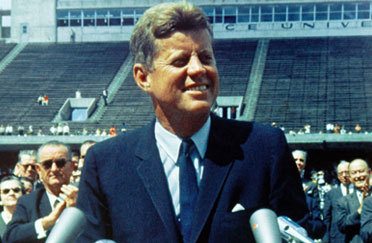This is the story of the USS John F. Kennedy: USS John F. Kennedy is the only ship of her class and the last conventionally powered carrier built for the United States Navy. The ship was named after the 35th President of the United States, John F. Kennedy, and was nicknamed “Big John”. The ship’s keel was laid at Newport News Shipbuilding on 22 October 1964. She was officially christened 27 May 1967 by Jacqueline Kennedy and her 9-year-old daughter, Caroline, two days short of what would have been President Kennedy’s 50th birthday. The ship commissioned, or had her active service ceremony, on 7 September 1968.
John F. Kennedy is a modified version of the earlier Kitty Hawk-class aircraft carriers. Originally scheduled to be the fourth Kitty Hawk-class carrier, the ship received so many modifications during construction she formed her own class. The ship was originally ordered as a nuclear carrier, using the A3W reactor, but converted to conventional propulsion after construction had begun.

On 22 November 1975, Kennedy collided with the cruiser Belknap, severely damaging the smaller ship. As a result of the collision with Kennedy's overhanging deck, JP-5 fuel lines were ruptured, spraying fuel over an adjacent catwalk, and fires ensued aboard both ships. Belknap's superstructure was gutted almost to the main deck, and seven of her crew killed. Aboard Kennedy, smoke inhalation claimed the life of Petty Officer 2nd Class Yeoman David A. Chivalette of Carrier Air Wing 1. .Ships in company, Claude V Rickets and Bordelon, stood alongside Belknap passing closeboard to fight fires.
In October 1983 John F. Kennedy was diverted to Beirut, Lebanon from her planned Indian Ocean deployment, after the Beirut barracks bombing killed 241 US military personnel taking part in the Multinational Force in Lebanon, and spent the rest of that year and early 1984 patrolling the region. On 4 December 1983 ten A-6 aircraft from Kennedy along with A-6 and A-7 aircraft from USS Independence took part in a bombing raid over Beirut, in response to two US F-14 aircraft being fired upon the previous day. The Navy lost two aircraft during the raid: an A-7E from Independence and an A-6E from John F. Kennedy were shot down by surface to air missiles. The A-7E pilot was picked up by a fishing boat, but the A-6E pilot Lt. Mark Lange died after ejecting and the B/N Lt. Robert “Bobby” Goodman was taken prisoner and released on 3 January 1984.
Kennedy had just returned to the U.S. in time to participate in 1994s Fleet Week in New York and Independence Day celebrations in Boston, Massachusetts before receiving an “All-hands” recall on 10 August 1990, for Operation Desert Shield. The ship was empty of fuel, and ordnance and equipment as it was ready to heading to the yards for some scheduled maintenance. Once the Warning Order was issued, the ship went into 24-hour supplies replenishment procedures. She took on all the supplies and equipment she had just been offloading. She took on additional fuel and ordnance while crossing the Atlantic Ocean. She departed the United States combat ready faster than any ship had accomplished since the Vietnam War. She departed on 15 August 1990, and became the flagship for the commander of the Red Sea Battle Force. At midnight on 17 January 1991 Kennedy’s Carrier Air Wing 3 commenced the very first strike operations against Iraqi forces as part of Operation Desert Storm. Between the commencement of the operation and the cease-fire, Kennedy launched 114 airstrikes and nearly 2,900 sorties against Iraq, which delivered over 3.5 million pounds of ordnance. On 27 February 1991 President George H. W. Bush declared a cease-fire in Iraq, and ordered all U.S. forces to stand down. Kennedy was relieved, and began the long journey home by transiting the Suez Canal. She arrived in Norfolk on 28 March 1991.
On 1 October 1995, John F. Kennedy was designated to be an operational reserve carrier and Naval Reserve Force ship with a combined full-time active duty and part-time Naval Reserve crew complement, assigned to the U.S. Atlantic Fleet. Kennedy would be available to deploy with either an active or reserve carrier air wing when mobilized in support of urgent operational requirements. In this capacity, John F. Kennedy’s new primary function would be to provide a surge capability, and in peacetime, to support training requirements
CV67 made more than 30 deployments worldwide during her career. After nearly 40 years of service in the United States Navy, Kennedy officially decommissioned on 24 July 2007. She was placed in a “Special” category requiring full dehumidification and cathodic protection services. In November 2009 she placed on “Donation Hold” as several museum groups sought the ship as a primary display ship.
In August 2010, two groups successfully passed into Phase II of the U.S. Navy Ship Donation Program, The Rhode Island Aviation Hall of Fame, Providence, Rhode Island and the USS John F. Kennedy Museum, Portland, Maine. On 19 January 2011 the Portland, Maine City Council voted 9–0 to not continue with the project to bring the ship to Maine.
Plans as of September 2014 had the Rhode Island Aviation Hall of Fame working to secure Pier 2 of the Naval Station Newport. These developments come after the former USS Saratoga (CV-60) was sold for scrapping earlier after years of being moored in Newport.
In late 2017, the Navy revoked John F. Kennedy’s “Donation Hold” status and designated her for dismantling. Her and her sister ship Kitty Hawk are the last two conventionally powered super carriers afloat.
Today, ex-JOHN F KENNEDY still sits on the Delaware River awaiting dismantling.
Article researched and authored by Joe LaPenna, Project Manager, Philadelphia

